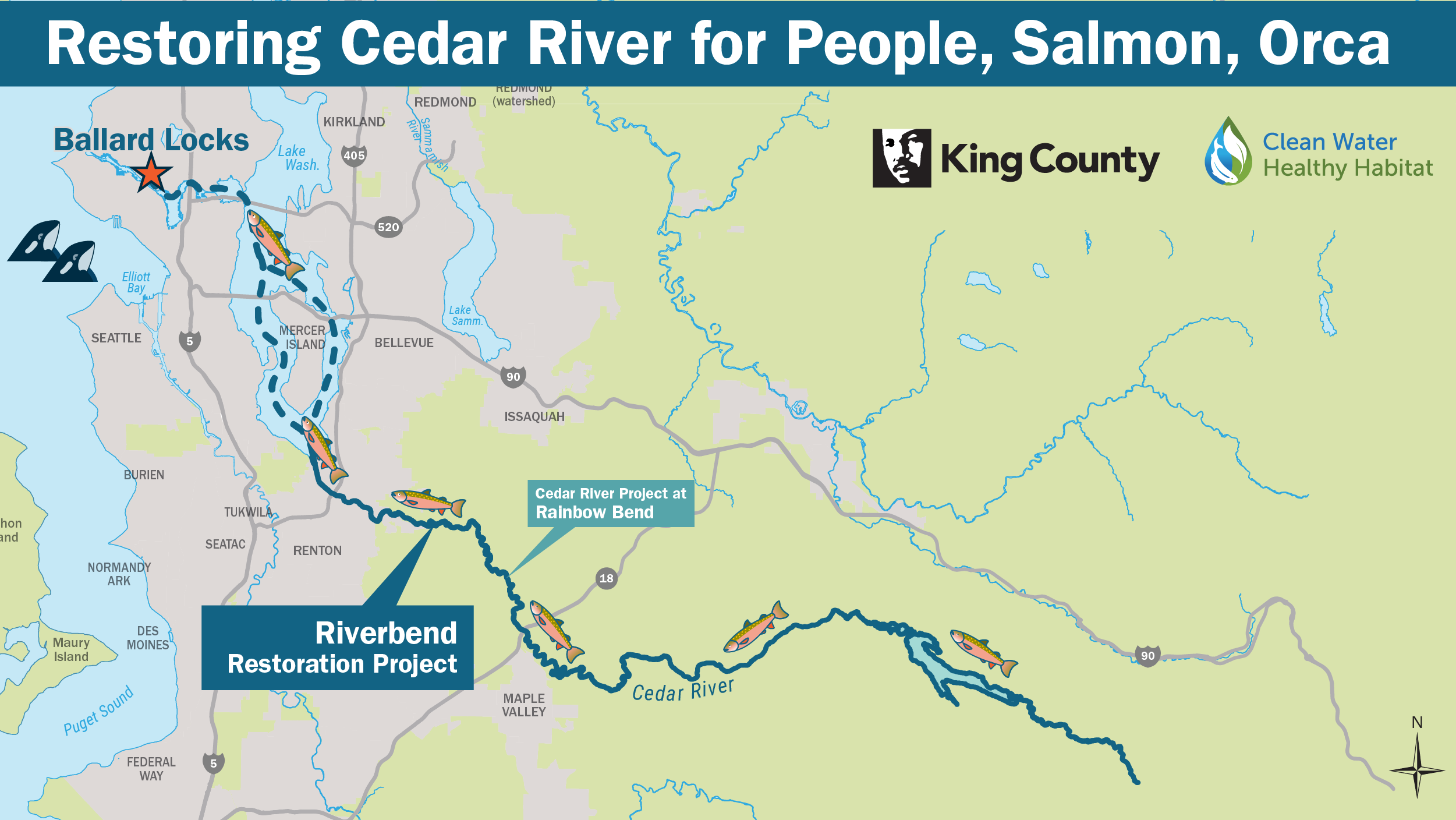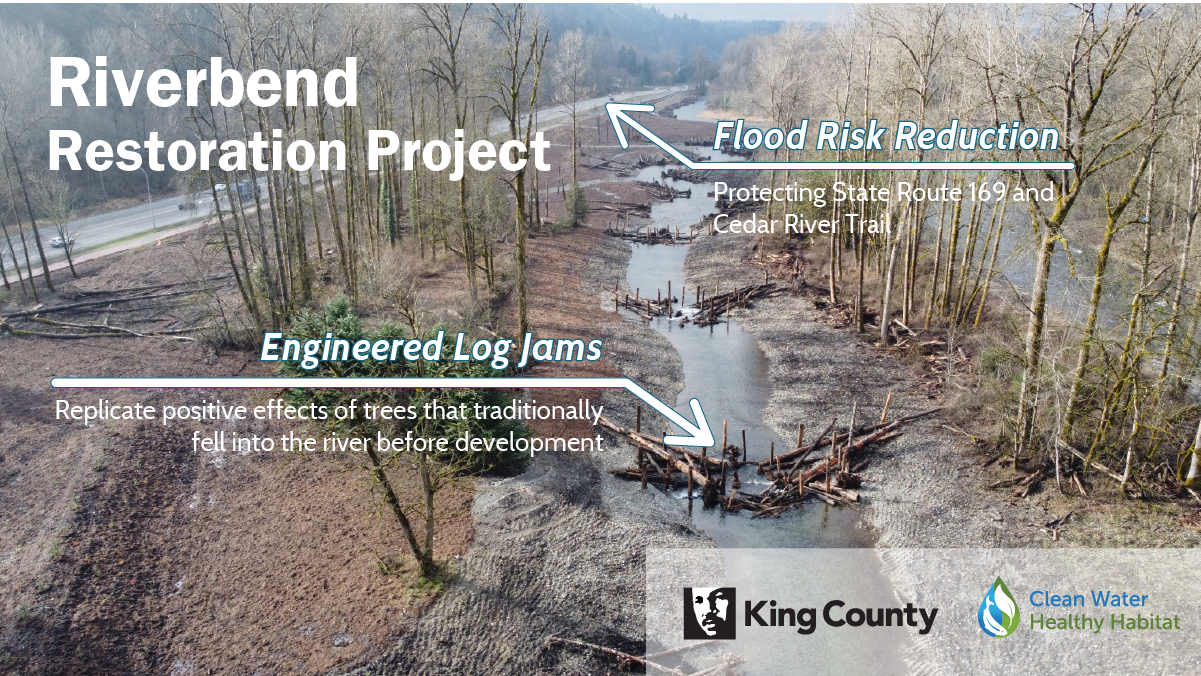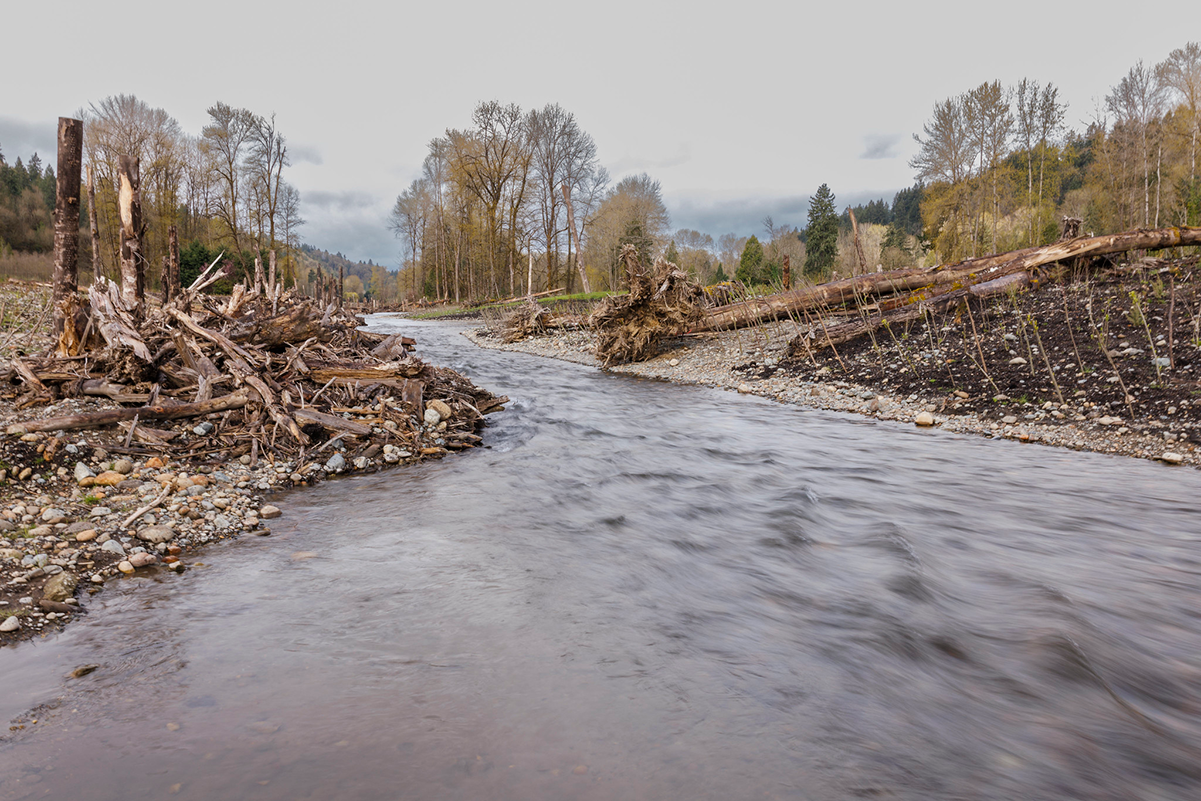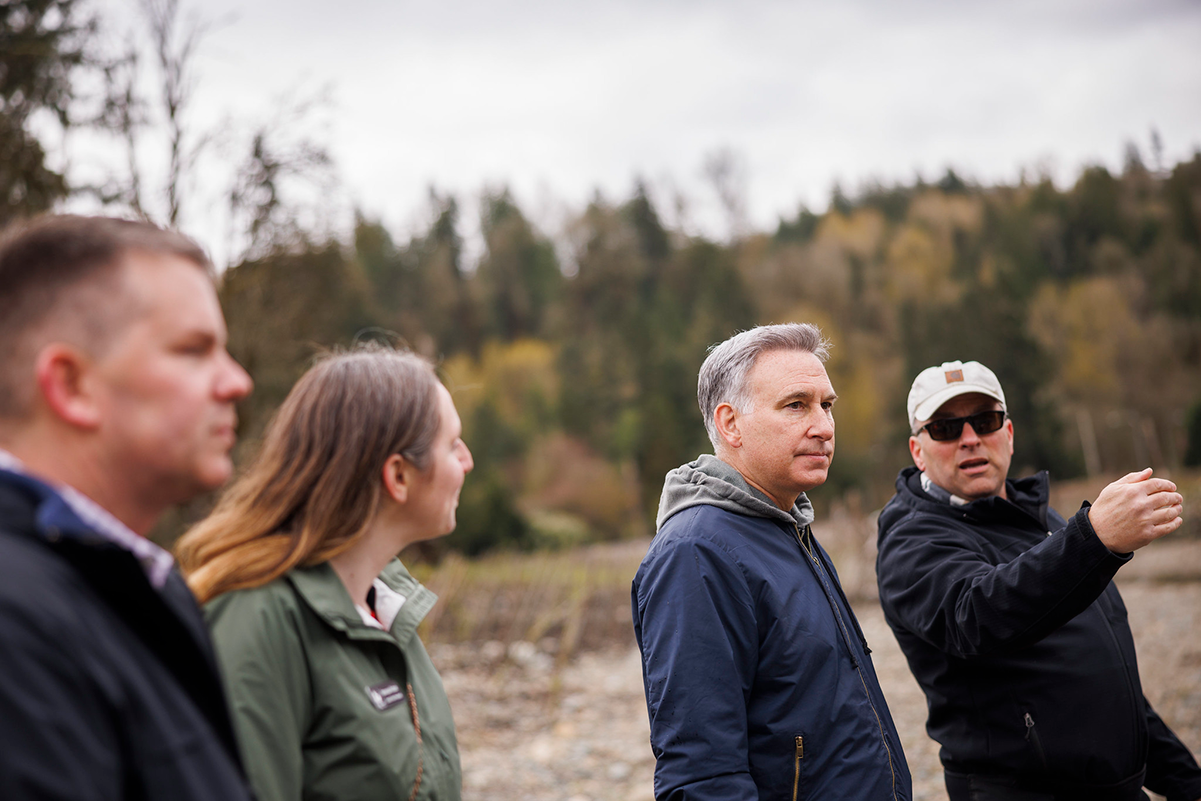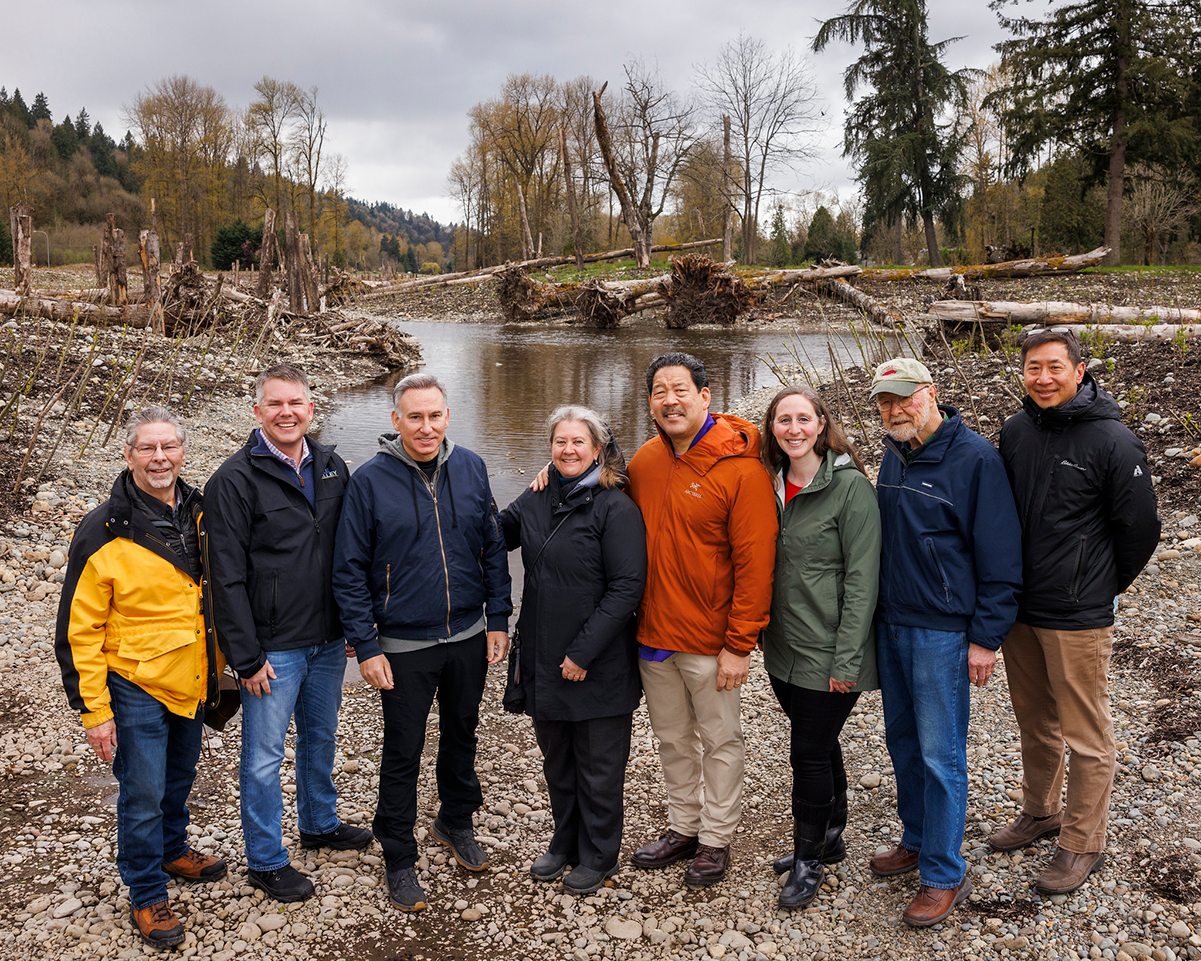Executive Constantine tours successful Riverbend site, a major Cedar River restoration project that reduces flood risks, improves salmon habitat, provides more food for orcas
Summary
King County’s recently completed restoration project along the Cedar River east of Renton simultaneously reduced flood risks, improved salmon habitat, and increased the food supply for southern resident orcas.
Story
King County Executive Dow Constantine today toured a recently completed project that restored a nearly mile-long segment of the Cedar River to a more natural state, simultaneously improving salmon habitat and reducing flood risks for people, homes, and infrastructure.
The Riverbend project restored 52 acres of floodplain east of Renton while creating side channels that provide slow-water, shallow habitat that is ideal for native Chinook salmon. It builds on the progress King County and partners made upstream with the successful Rainbow Bend restoration project that was completed in 2013.
Restoring habitat along the Cedar River – which flows from the Cascades to the southern tip of Lake Washington – increases the odds of Chinook salmon reaching Ballard Locks on their way to the Pacific Ocean while also providing sustenance for southern resident orcas. The slower, meandering side channels provide salmon with a safe place to rest, hide from predators, and prepare for the transition from freshwater to saltwater.
“We have successfully restored a nearly mile-long stretch of the Cedar River, an inspiring achievement that reduces flood risks, improves salmon habitat, and provides more food for Puget Sound orcas,” said Executive Constantine. “Our success at Riverbend is an example of what we are achieving throughout King County with Clean Water Healthy Habitat, unifying efforts to produce better results faster for people, fish, and wildlife.”
“Ensuring a healthy environment in our waterways and natural areas is core to our responsibility as a city and regional leader,” said Seattle Mayor Bruce Harrell. “Our teams at Seattle Public Utilities have been critical in this effort to restore this natural area on the Cedar River and build resilience to the impacts of climate change, producing better outcomes for the salmon that travel downstream to Lake Washington and reducing flood risks to the surrounding communities. The Cedar River Watershed is also a major source of drinking water for Seattle, making stewardship projects like this vitally important for our health and future.”
King County crews removed a levee installed in the 1960s, recreating natural systems that require less maintenance and are more resilient to climate impacts. They installed engineered logjams that replicate the positive effects of trees and other wood debris that traditionally fell into the river before the surrounding landscape was altered for development.
The team had to modify the project design after the Cedar River broke through the aging levee during a flood in February 2020, effectively eliminating Cavanaugh Pond – a former gravel pit – before crew members had the opportunity to remove the last segments of the levee themselves. The river filled about half of the former pond with gravel while crews added more so it would be the same level as the riverbed, providing better habitat for juvenile salmon and making it less enticing to predators – such as trout and bass – that prefer deeper, slower waters.
The $17.9 million project was coordinated by King County’s Water and Land Resources Division. The King County Flood Control District contributed about 30% of the funding while Seattle Public Utilities contributed funding and expertise in procurement and management of the construction project. King County secured more than $12 million in Washington State Floodplains-by-Design, Puget Sound Acquisition and Restoration, and State Salmon Recovery grant funding.
The Riverbend restoration project alone achieves 40% of a goal established by the Lake Washington/Cedar/Sammamish Watershed, known as WRIA 8, to add 130 acres of floodplain connected to the Cedar River by the end of 2025. The WRIA 8 Chinook Salmon Conservation Plan identifies floodplain habitat, such as the Riverbend project, as the highest priority for salmon recovery in the Cedar River. Because of the importance of this project, the WRIA 8 Salmon Recovery Council directed and helped secure local, state, and federal salmon habitat grant funding for the project.
The King County Flood Control District acquired the flood-prone Riverside Mobile Home Park and helped residents relocate out of harm’s way. Coordinating the habitat restoration project with nearby flood damage repairs saved time and money.
King County's Water and Land Resources Division then acquired the project site with revenue generated by the county's Conservation Futures program, the primary funding source for the Land Conservation Initiative to protect the last, best 65,000 acres of open space within a single generation.
It is the latest in a series of projects coordinated by the King County Department of Natural Resources and Parks to restore watersheds to a more natural state while achieving multiple benefits, advancing Executive Constantine’s Clean Water Healthy Habitat initiative to produce better results faster for people, salmon, and orcas.
Images
Relevant links
- PHOTO GALLERY: Riverbend restoration project
- VIDEO: Restoring Cedar River for people, salmon, orcas
- VIDEO: Highlights from Executive Constantine's tour of Riverbend
- Clean Water Healthy Habitat
- TRACKS: An interactive map of environmental stewardship
Quotes
We have successfully restored a nearly mile-long stretch of the Cedar River, an inspiring achievement that reduces flood risks, improves salmon habitat, and provides more food for Puget Sound orcas. Our success at Riverbend is an example of what we are achieving throughout King County with Clean Water Healthy Habitat, unifying efforts to produce better results faster for people, fish, and wildlife.
Ensuring a healthy environment in our waterways and natural areas is core to our responsibility as a city and regional leader. Our teams at Seattle Public Utilities have been critical in this effort to restore this natural area on the Cedar River and build resilience to the impacts of climate change, producing better outcomes for the salmon that travel downstream to Lake Washington and reducing flood risks to the surrounding communities. The Cedar River Watershed is also a major source of drinking water for Seattle, making stewardship projects like this vitally important for our health and future.
The WRIA 8 Salmon Recovery Council is proud to have helped direct and secure nearly $12 million in local, state, and federal grant funds for the Riverbend project. This floodplain reconnection will significantly increase the amount and quality of habitat for multiple salmon species. Floodplains provide places of refuge for young salmon to get out of fast-moving flood waters. In these slower waters, they can feed and grow, which helps improve their chances of survival on their way out to the ocean.
In addition to salmon conservation benefits and the protection of at-risk homes, the Riverbend project made emergency repairs that addressed the mounting risk of flood damage to the Cedar River Trail, SR 169, and underground utilities. This critical, multi-benefit project was only possible through the partnership of multiple governments, and I’m proud to have supported it.
For more information, contact:
Doug Williams, Department of Natural Resources and Parks, 206-477-4543

 Translate
Translate
